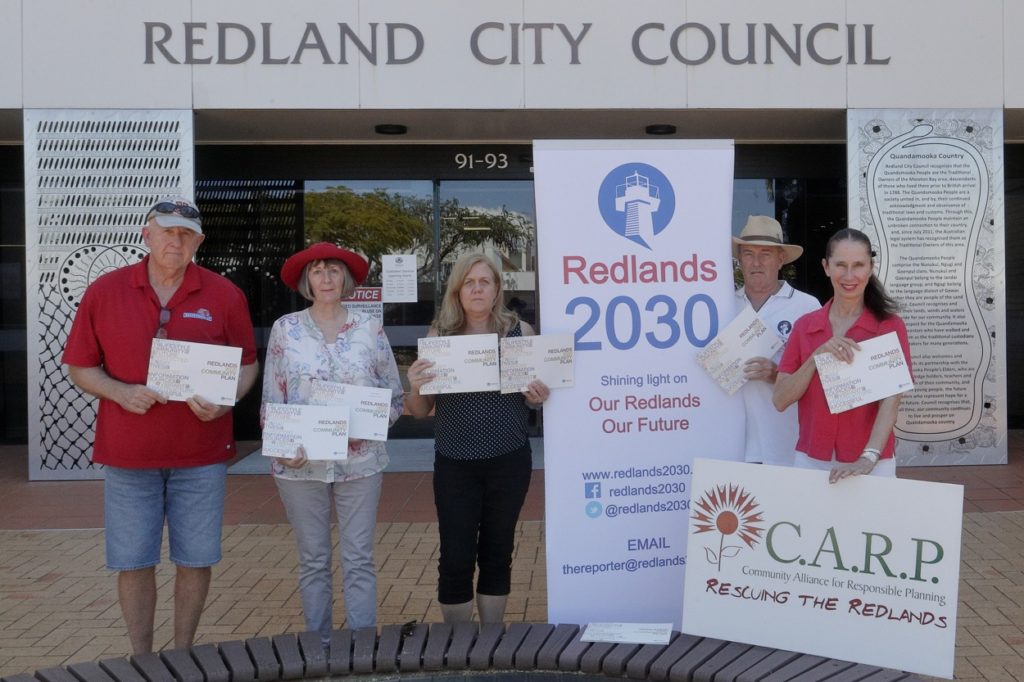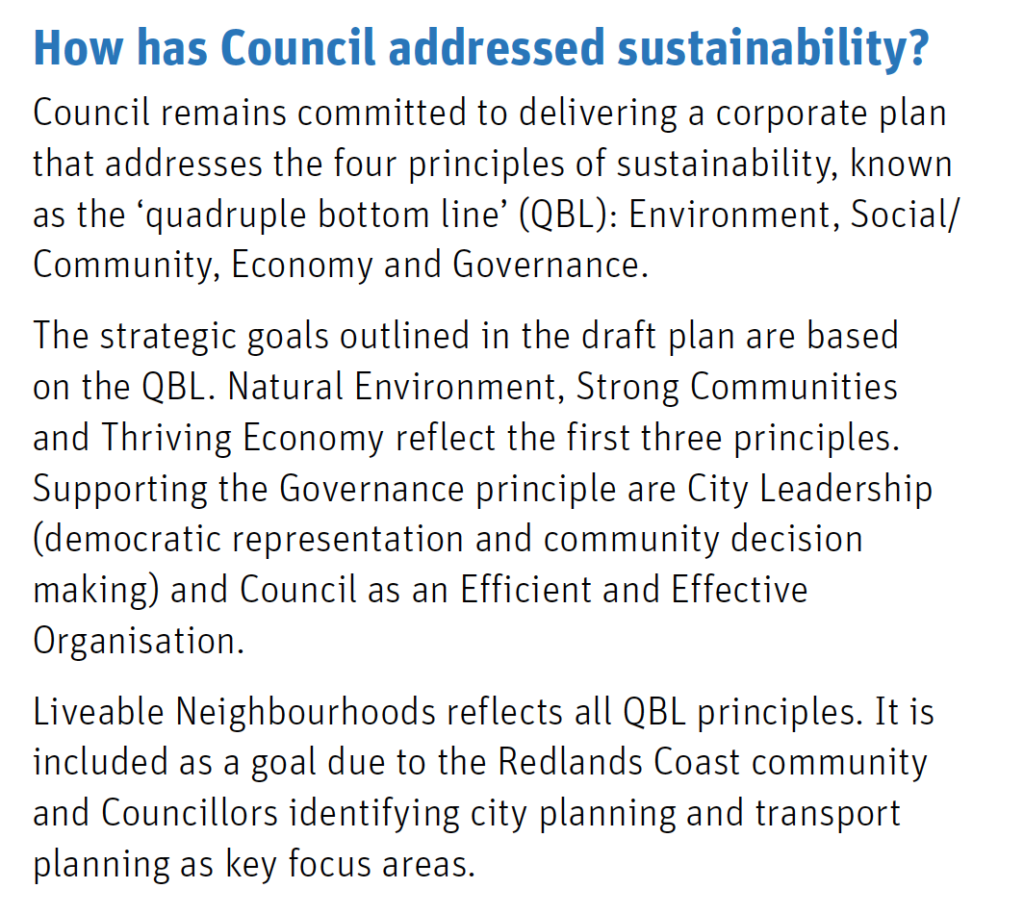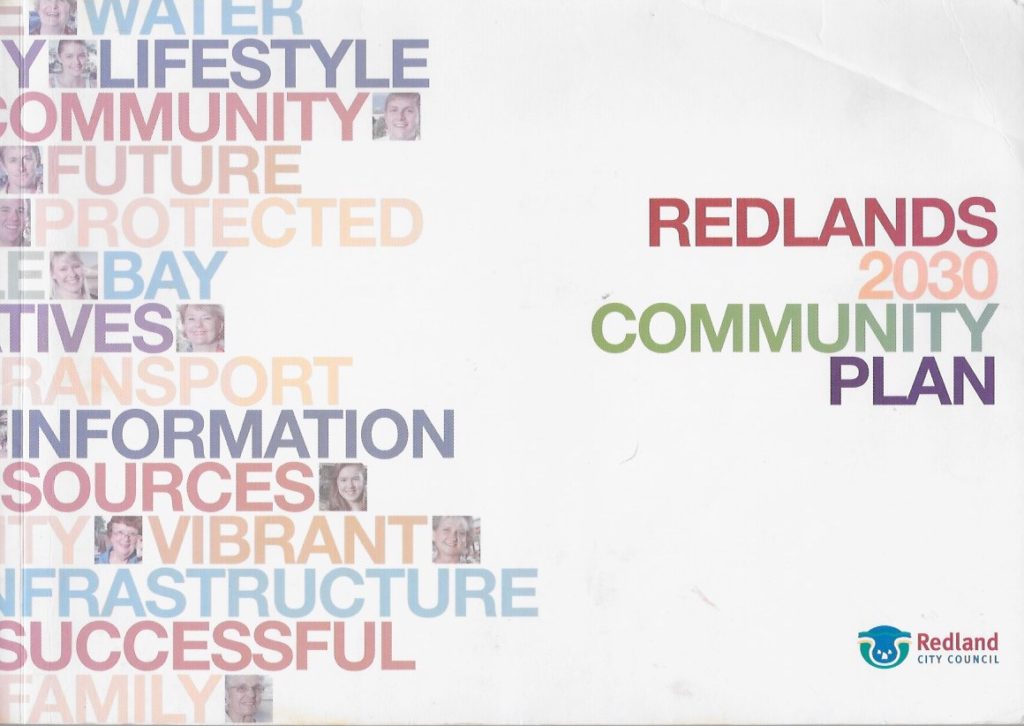
The Redland City Council’s attack upon the Redlands 2030 Community Plan rankles letter writers. There are those who hold the Community Plan as an exemplar of community based planning and a very credible output. The Quadruple bottom line (QBL) approach is challenged as a dated foundation issue.
Clearly, the previous “bottom up” Community Plan is more in line with community values than new Corporate Plan which took a “top down” or Councillor driven approach. One writer poses a question about the Community Plan as still being the plan of the “Community” and the new Plan belonging to an out of touch Council!
If you have something to say to the Redlands community, email your letter to: theeditor@Redlands2030.net
The Corporate Plan was not built on community values or interests
Editor R2030
A critical failure in the Councils new Corporate Plan is the lack of an evaluation of the discarded Community Plan. This failure is at odds with established planning processes! An evaluation of an older plan helps set the scene for a new plan. A formal evaluation of the Community Plan was intended when it was adopted in 2010 so why isn’t there any evidence of an objective evaluation.

Further, to date there is no evidence of Council undertaking the required five year reviews of the Community Plan. The real goal seems to have been to erase the Community Plan from the memory banks. Another glaring failure is that Council never established the promised Community Reference Group that was to ensure the plan was delivered. The council of 2012 clearly didnt want independent witnesses to the path they took and subsequent councils have rolled along the same path.
Many questions arise from the way the Community Plan has been discarded including sources that report that in 2012 (after the local government election) a copy of the Redlands 2030 Community Plan was strewn across the floor of the Council Chambers. That action was reportedly accompanied with statement that “Redlands 2030 Community Plan was no more”.
The new Corporate Plan completes the process of discarding the well credentialed and highly regarded community plan. But fails to give a compelling rational for why?
Arguably this decision confirms that councillors put little weight on the views of the community, community values or on comprehensive participation processes.
BP
Cleveland
Is the Corporate Plan’s QBL model is flawed!
R2030 Editor
If you were swayed by the gloss and spin attached to the new Plan you would will be bitterly disappointed when the Council tries to implement the processes to achieve those goals and objectives because it embraces a flawed economic model. The economic approach touted cannot possibly be attained for the simple reason that the economic model that Council intends to use. The Quadruple Bottom Line (QBL) approach consisting of the four pillars environment, society/community, economy and governance is flawed and bears no relation to reality. The adoption of the QBL as the guiding economic model is stipulated in Fact Sheet #1 and on Page 11 of Corporate Plan.

The QBL model is poorly explained but even so there is widespread debate about the relevance of QBL because it treats the “four pillars” as being on the same level of the organising system. Being on the same level infering that these pillars can be traded-off against one another to get the desired outcome.
Those who endorse this model overlook that the reality, which is that the system is a nested hierarchical system. The highest level being the environment. A simple analogy is a set of “Russian Dolls”.
The Russian Doll analogy must start with a the largest or external doll and then a series of progressively smaller dolls. Each doll fitting inside a slightly larger doll. The largest doll represents the environment, and the next largest doll represents society/community, then the third doll is the economy which fits inside the society doll and the fourth doll represents governance which fits inside the economy doll.

Each doll that fits inside another is limited in size by the doll it fits in. In other words, each of the sub-systems ie society (community), economy and governance operate or function within the limits imposed by the environment if the system as a whole is to be sustainable. Thus, there is a single bottom line, the environment, it is not a quadruple one.
Consider the example of a fenced paddock with a herd of cattle in it. The cattle can remain indefinitely in the paddock and meet their needs for survival and reproduction if the stocking rate is less than or equal to the rate at which the resources in the paddock renew themselves. If the stocking rate is greater than the rate of resources in the paddock renew themselves, the cattle cannot remain there indefinitely because the herd will “eat” itself out of food and water. In other words it will degrade the quality of the paddock and it will not be able to support the herd which eventually will die out.
The fenced paddock represents the physical environment. The herd represents society (community). The rate at which the herd uses the limited resources in the paddock in relation to the rate at which those resources are replenished represents the economy. The farmer represents governance. The farmer’s decisions on stocking rate within the paddock determine whether the system is ecologically sustainable or unsustainable.
The implication of the QBL approach is that the stated goals of the Corporate Plan cannot be achieved. The plan won’t work. because it is based on a fatally flawed economic model which will undermine spirit of cooperative collaboration established in the previous Community Plan.
Critically the Natural Environment objective of sustainable development will not be achieved because trading-off environment beyond the limits it imposes on its subsystems ensures it cannot be sustained. It is equivalent to exceeding the carrying capacity in the example of the herd in the paddock. Also sustainable management of liveable neighbourhoods is not achievable if anything other than a single bottom line of the environment is used in the economic model.
The economy cannot be sustained in a finite environment if any economic model on which it is based does not have the environment as the single bottom line. It is essentially the same as living within our means. In this case, it means that we must live within the limits that are imposed on us by the environment.
As soon as environmental limits are exceeded, development cannot be sustained, certainly not indefinitely. The faster we degrade the environment then the sooner the system will collapse.
The Corporate Plan asserts, that “by 2041, the population of Redlands Coast is expected to be approximately 192 000 people. On this assertion alone the Corporate Plan is merely a token response to an unstated growth paradigm. This growth paradigm is derived without any links or line of sight to the much vaunted QBL.
KH
Victoria Point
The Community Plan lives!
Editor
The Council does have a mandate to separate the community plan from the corporate planning process. My reasoning goes like this. The Newman government abolished the compulsory community planning process which had to be linked to the corporate plan. As a consequence the link is now voluntary.

The Redlands 2030 Community Plan was adopted by Council in 2010. In the Plan there is a section (p60) that states that Plan is “at the forefront of Council’s planning, policies and strategies and the community’s own plans for the next ten years.” which is now, 2020. It doesn’t have to be at the forefront of Council’s corporate planning after 2020 unless Council wants it to be there.
Then also on p60 there is the statement that “The plan will be reviewed with the community every five years.”
So this means that the Council can unhook the Community Plan from the Corporate Plan and it can say that the Corporate Plan supersedes the Community plan’s long term vision and goals for the city. Moreover, RCC can write new visions and goals. But keep in mind, these are RCC corporate goals, but not necessarily the community’s goals. The new corporate plan will also be Council’s plan.
The Redlands 2030 Community Plan remains the community’s plan and may well continue to guide the community up to 2030 or until Council or another representative body resumes community-based planning. The council could always move a motion to rescind R2030 in order to more formally removes itself from its previously endorse community plan. But why should Council want to draw attention to its high handed approach to any of this.
Suffice to say the Council can supersede the community plan for its own corporate plan but Council cannot just take the Redlands 2030 Community Plan away from the community. the community basis of the Community Plan can never be replaced by the minimal and selective consultation and Councillor driven process used to “make” the new corporate Plan. By this I mean, the council can turn its back on the community and the community’s Plan but that action does not diminish the validity or the moral authority of the Redlands 2030 Community Plan.
BB
Wellington Point
More Letters To Redlands2030
The ABC Outside Broadcast More On Cowley Street
More reactions to Cowley Street koala habitat clearing
Cowley Street Koala Habitat Clearing Stirs The Community
Please note: Offensive or off-topic comments will be deleted. If offended by any published comment please email thereporter@redlands2030.net
One Comment
As a believer in democratic processes and citizen responsibility to participate intelligently in our government, I try to keep informed. But I find it impossible to keep across the amount of information from so many sources for all levels of government and still have a life. Not having lived permanently in the Redlands until a couple of years ago, I am finding it very difficult to understand the planning process. Can somebody explain for instance what is a “corporate plan” and what is a “community plan” and how do they relate to the “city plan”? I have always understood a “corporate plan” to be a strategic plan for one organisation, not a city or
community. Does this post imply that RCC’s “corporate plan” is a plan for us and our communities rather than an internal working document for the council? Surely not. irrespective of what is contained in it no-one could be that tone deaf that they would label a plan for communities and a city a “corporate plan”. This must be something else surely?